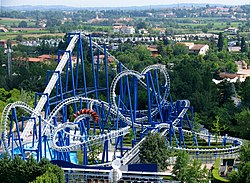Suspended Looping Coaster
| Suspended Looping Coaster (SLC) | |
|---|---|

|
|
| Status | In Production |
| First manufactured | 1994 |
| No. of installations | 41 |
| Manufacturer | Vekoma |
| Vehicle type | Roller coaster train |
| Height restriction | 130 cm (4 ft 3 in) |
| Type | Steel - Inverted |
| Lift system | Single chain lift hill |
| Suspended Looping Coaster (SLC) at RCDB | |
The Suspended Looping Coaster (or SLC) is a model of steel inverted roller coaster built by Vekoma. There are at least 39 different installations across the world. The minimum rider height requirement is 130 centimetres (4 ft 3 in).
The first Suspended Looping Coaster installation was El Condor at Walibi Holland in the Netherlands. It was initially designed to run with ten cars in each train. Trouble with this configuration lead to the trains being shortened to eight cars to a train.T3 at Kentucky Kingdom was the second prototype model Suspended Looping Coaster and the first in the United States. Like El Condor, it was designed to run with ten cars in a train, though T3's trains were shortened to seven cars for similar reasons.
The roller coaster is considered to still be in production as the latest new installation (i.e. not relocated) was Roller Coaster Mayan in 2015 at Energylandia
There are several different layouts of Suspended Looping Coasters although most feature a similar pattern. The ride starts by taking riders up a 33.3-metre (109 ft) chain hill. Once at the top, the train goes down a steep, banked turn to the right where it enters the first inversion element - a roll over. A roll over (also known as a Sea serpent roll) first features a Sidewinder quickly followed by a reverse sidewinder. Upon exit from this element, the train goes up a hill which features some banking at the top before descending and approaching the ride's next inversion - a sidewinder. A sidewinder is similar to an Immelmann loop however it features a half loop followed by a half corkscrew (rather than an inline twist). From the exit of this sidewinder, the train goes into a sharp helix before entering the ride's final two inversions - inline twists. These two twists are followed one after the other. A banked curve to the right turns the train back around to face towards the station. At this point some models feature an additional helix to the left while others simply continue straight into the brake run. The standard model also has a relatively compact layout, providing for "footchoppers".
...
Wikipedia
